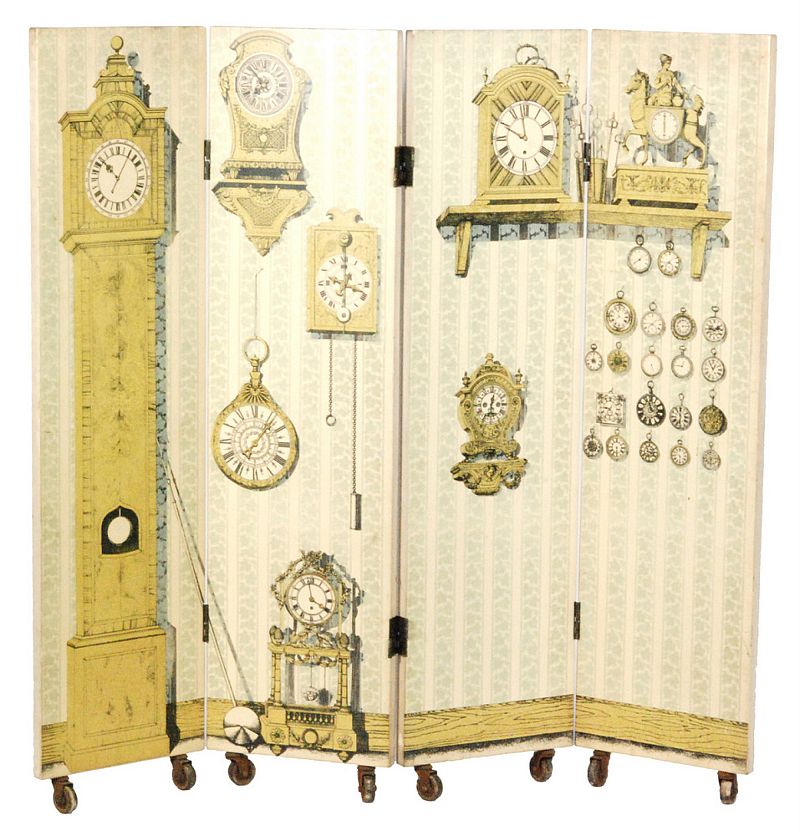The magical world of Piero Fornasetti
by Will Farmer
Over the last 10 years Fornasetti’s designs have become more and more popular as his son Barnaba and now company director has transformed the firm into a global brand which is loved and collected around the world. From the surreal to the simply beautiful his work is now a must have amongst designers and passionate collectors. As a new exhibition opens in Venice his work is as relevant today as when first imagined over 60 years ago!
Piero Fornasetti was born on the 10th November 1913 in Milan. A natural artist and designer he began drawing incessantly from the age of ten always practicing and developing what was an intuitive skill. As a young man Fornasetti decorated his parents home with frescos influenced by Renaissance images seen in books, while balloons and airplanes covered the ceilings scenic views adorned the walls. In 1930 and aged just 16 the young Fornasetti chose to revolt against the preferred path chosen by his father abandoning his accountancy studies to take up drawing classes at the Accademia Brera. After only two years Fornasetti found himself expelled for insubordination!
In 1933 Fornasetti embarked on a path of creative discovery that was to develop into a lifetime of artistic expression in all walks of design and interior decoration. One of Fornasetti's earliest and most significant projects was the creation of a number of silk scarves for the 1933 Milan Triennale that were printed in a trompe l’oeil effect using newspaper print for pattern. Despite being rejected by the committee they marked the beginning of his love for quirky surface pattern and a desire to exhibit his designs on an international scene. Undeterred Fornasetti returned over following years with stronger and more adventurous designs. By 1940 he had caught the attention of Gio Ponti, an Italian architect who was to become Fornasetti's most important and loyal patron. Together their collaboration on furniture designs and large scale interior decoration projects created some of the most significant landmarks of 20th century design.
Fornasetti was fundamentally a visionary, a designer who transferred his fervent and formidable imagination to everyday objects. To call him a designer is by no small measure underplaying his achievements. He was an artist, illustrator, graphic designer, craftsman and of course a businessman. The greater majority of his work however is decoration applied to objects designed by others, be it the interior of a casino or the surface of a desk.
A fan of surrealism Fornasetti indulged himself with a combination of daring wit and subtle humor. He clearly enjoyed provoking his audience and challenging what was perceived to be ‘normal’. The foundation of his style is the clever interplay between illusion and reality. He looked to history as a source reference, from Renaissance to Rococo Fornasetti owned an enviable library and print collection which he new intimately. This expansive knowledge of historical styles provided him with a never ending selection of images and motifs which could be re-worked in countless obtuse ways for application to anything from umbrella stands to sideboards. Naturally for Fornasetti one idea always led to another, often a small detail would be just the starting point marking the germination of endless variations arising from one idea.
Fornasetti's fanciful pieces were always witty and imaginative. In his motifs, he favored the sun, moon and stars, playing cards, animals, flowers, architecture and cityscapes to name but a few. One of his most ‘iconic’ images and one that I personally love is that of operatic soprano Lina Cavalieri. While glancing through a 19th century French magazine, Fornasetti came across a simple monochrome image of her face. Her classical proportions and feminine beauty instantly captivated him and he went on to reproduce her likeness in over 500 variations transforming her into a never-ending series of images placing her face over the surface of a balloon, transformed into a lioness or repeated in a kaleidoscopic pattern of repetition. “What inspired me to create more than 500 variations on the face of a woman?” Fornasetti asked of himself. “I don’t know, I began to make them and I never stopped.” Fornasetti renamed her ‘Julia’ and the range was titled ‘Themes & Variations’, it remains one of Fornasetti’s most instantly recognizable and popular and the image has been applied to virtually every element of interior decoration from cushions and carpets to cups and cupboards! A small dish or cushion cover can start from as little £30 while a small sideboard will cost upwards of £3000.
Fornasetti was quite simply prolific! His output is one of the largest back catalogues of a 20th century designer with over 11,000 creations to his name. The associations he formed, commissions he undertook and the quantity of work he created made him a giant of post war Italian design. His work created a style and theme that was to become intrinsically Italian. While many contemporaries the world over looked to replicate the use of print and pattern for surface decoration few could come close to the creative genius of Fornasetti.
However recognition has to be made to the designers he chose to work with, including Richard Ginori and Gio Ponti. Ponti was over twenty years older than Fornasetti when they met however the great Italian architect was instantly impressed with the young designers skills and creative mind. Their combined genius created a series of highly important interior schemes with equally important furnishings. Their bureau-bookcase represents one of the earliest collaborations by Ponti with his young protégé. Over subsequent years it was re-visited with many variations however it remains the signature landmark of their collaborative genius. Recently an early original example created in 1950 was sold at Christies in London for £102,000!
Being as distinctive as they are bargains are rare! Pieces are easy to identify and research so many national and international auction houses and online sellers usually know exactly what they have. Early issues are always more valuable and sought after however period pieces can still be purchased in the tens of pounds while significant pieces can very quickly realize in the thousands.
The modern articles issued from the Atelier Fornasetti are set to be as important to future generations as the originals are to todays. Each design is issued in a strict limited edition and each are executed to the same exacting standards of the originals. Each is hand crafted and painstakingly decorated with a unique printing process where images are transferred on to specially prepared lacquered surface. These aren’t for the faint hearted however as we are talking of investments in the thousands however I feel sure that in the future they will prove to be safe investments while giving years of pleasure.
Visit our 20th Century Design department page.
Posted on 1 July 2019
Be in the know
Sign up for auction email alerts so you never miss another sale at Fieldings!
Register now



